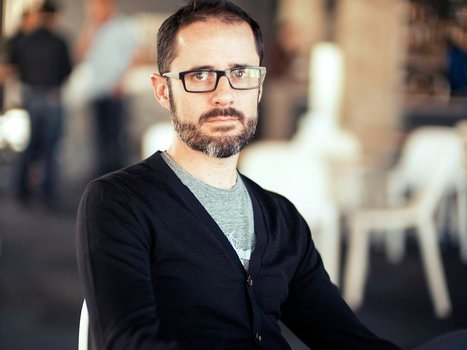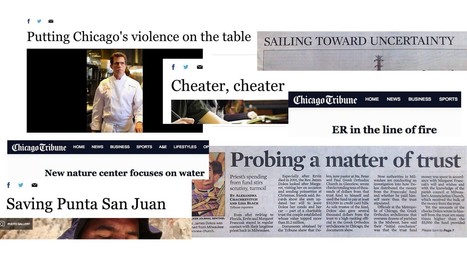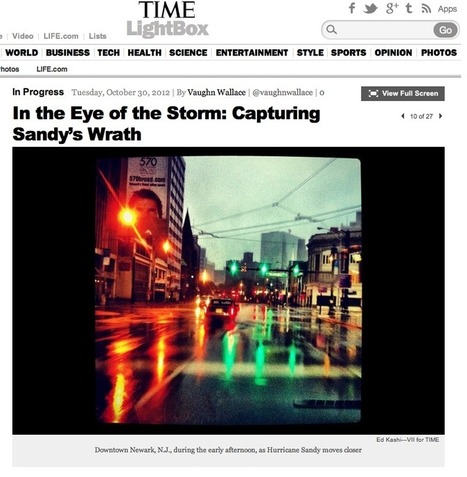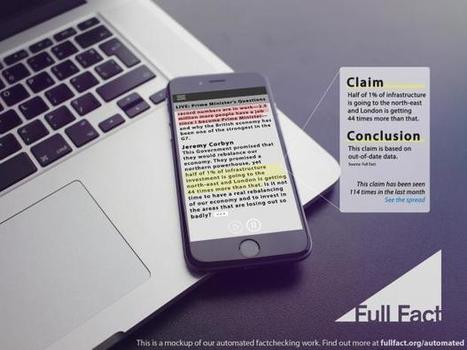 Your new post is loading...
 Your new post is loading...
Four days into 2017, Medium's employees came to work and were told that one-third of them, 50 people, were fired.
They were shocked. Their adored boss, billionaire CEO Ev Williams, best known as the cofounder of Twitter, seemed to care so deeply for each of them.
But he told the world about the layoff in a blog post even before all the people who lost their jobs were informed, a former employee tells Business Insider.
Some of them found out through industry buzz that they had lost their jobs, one person told us....
Online, your product is unbundled. You get 10 words. Or 8. Or maybe 13, like I used above, to market your work. Digital success is like selling a newspaper story by story rather than day by day or week by week. And in selling that day’s paper, by subscription or newsstand, there’s just less urgency to make the headline awesome on that 150-word story buried at the bottom of page 11. Sections and geographic centers all are comfortable assumptions you can’t make in digital headlines. You must have a certain sense of desperation in writing web headlines, like those eight words are the difference between that column’s or blog’s life or death. Mostly, because it is. You aren’t owed readership. Your headline helps earn it — along with a handful of other factors like author and brand.
So any strategy involving growing and sustaining digital audience must incorporate excellence in headline writing. Must.
A few points to clarify here as we begin. I’ll be discussing writing for readers here, not for search engine optimization. That will be a consideration at times, but mostly we’re talking about people creating headlines for people....
In 1977, according to the AP style guide I still occasionally refer to, using the acronym “TV” as a noun when writing about television was not advised.
“Acceptable as an adjective or in such constructions as cable TV [italics theirs]. But do not normally use as a noun unless part of a quotation,” counsels the item on “TV” in the 1977 edition of the AP Stylebook -- formerly titled “The Associated Press Stylebook and Libel Manual.”
Today we use “TV” and “television” more or less interchangeably as nouns, although the former is probably used more now than the latter. One thing the 1977 Stylebook reveals, however, is that “media” -- whether electronic or otherwise -- was not nearly the obsession for news organizations that it is today.
Part of the reason was that the world at large was not nearly as obsessed with media and technology -- and the companies responsible for them -- as we are now. There was so much less of it then too, obviously....
Five Steps to Multimedia Storytelling Is a valuable, free course offered through Poynter News University.
TITLE:Five Steps to Multimedia StorytellingTYPE:Self-Directed Course T IME ESTIMATE:This course takes about one to two hours to complete.
ABOUT SELF-DIRECTED COURSES
In a self-directed course, you can start and stop whenever you like, progressing entirely at your own pace and going back as many times as you want to review the material.
Want to spread your wings beyond print reporting, but don’t know where to start? In this course, you’ll learn the basic steps of telling your story with multimedia. You’ll discover ways to map out your story before you head out to do your reporting. And you’ll learn when to use such tools as audio, video and graphics.
WHAT WILL I LEARN? - Upon completing this course, you will be able to:Identify the elements in a multimedia story. - Understand which stories are more suitable for multimedia - Sketch a concept for a story - Identify tools needed to gather content in the field...
Since launching in private beta last year, Medium has been building up its platform, which aims to offer a simple but 'beautiful' reading and writing experienceIt was one year ago this week when the online publishing world was abuzz with the news that two of Twitter's founders had launched a new platform called Medium, in private beta.In the early days only a select group of people were allowed behind the scenes to contribute content to Medium.
Some details on the platform were made public via an announcement post from Ev Williams, in which he described Medium as "a new place on the Internet where people share ideas and stories that are longer than 140 characters and not just for friends".In the past year the group of people invited to write has grown, and we are told it "should be a short wait from now" when the platform will be available for all to use.
The main aim of Medium is to be "the best place to read and write about things that matter", and this emphasis on both the writing and reading experience has been reflected in its approach over the past 12 months....
You'll never believe Peter Koechley's OUTRAGEOUS headline writing tips. For most of us in the online journalism business, writing headlines basically amounts to guesswork. Will people click on this? Are there enough nouns in here for Google to find it? Does this line break look weird? Should I use a question mark? An exclamation point? For Upworthy, it’s more akin to a science — and not one of those mushy sciences like anthropology or psychology, either. We’re talking straight-up particle physics. For every article they publish, its writers come up with 25 headline options. They then A/B test the four most promising before settling on a winner. The result: In just 11 months, with a smallish staff and not much original content, Upworthy has built a sizable audience (8.7 million monthly unique visitors as of last November) for its socially progressive message, plus a Facebook following of more than 1 million fans....
The blog is dead.I don't say it lightly; I've been blogging since 2000, moving from an email list I started in the '90s to Blogger to TypePad to Wordpress.com to Wordpress.org. ...So I see that moving my blog around like this is just staving off the inevitable; we are moving to collections and curations, to mobile content, and to different authoring tools. Think for a moment about the incredible popularity of Tumblr, or of Pinterest. I believe they are early iterations of the content revolution. I told my journalism students, who are just being taught by their professors that the new way is "digital first," that they have to stretch again--this time all the way to "mobile first."... [Francine Hardaway's provocative Fast Company article is a MUST-READ for every current and future blogger, PR and content pro! She really captures "what's next."~ Jeff]
Via Angela Nibbs
The Hurricane Superstorm Sandy storylines are still unfolding, but one thing became clear on Monday as winds and water overtook New York City and New Jersey in historic proportions: Digital media deepened the transformation of the disaster narrative. Here’s some of what’s out there today in various storytelling forms... [Very interesting to see the various forms of storytelling ~ Jeff]
14 pointers on finding sources and stories using social media... Finding sources, nurturing contacts and checking facts by phone have long been key to successful journalism. This guide on using social media to research stories outlines the many ways reporters can put those traditional journalism skills into practice on social media platforms. The first problem in searching is one of noise. According to figures from March, more than 1 billion tweets were being posted every three days, so how can journalists sort the social media chaos and find contacts and stories? This guide gathers tips from Malachy Browne, news editor of social news gathering agency Storyful; David Wyllie, an editor at Breaking News, a social media breaking news service owned by NBC News; and investigative journalist and trainer in advanced online research skills Colin Meek.... [These tips will be useful for PR, bloggers and content producers too ~ Jeff]
This week, a guest essay from my colleague Patrick LaForge on a perennial problem - leads (and other sentences) that tax readers' patience:... No one sets out to write an opening sentence so long that it frustrates and irritates readers. But that’s what we sometimes do. Writers are not always the culprits. Too often, editors are the ones overstuffing leads with background, context and tangential explanations. It’s a collective effort. We need to do better. ••• Two recent examples weighed in at 55 words each and actually prompted reader complaints...
In the wake of the revelations that Jonah Lehrer is a serial self-plagiarist, Josh Levin declares that if you’re an “ideas man”, you shouldn’t be a blogger... Lehrer shouldn’t shut down Frontal Cortex; he should simply change it to become a real blog. And if he does that, he’s likely to find that blogs in fact are wonderful tools for generating ideas, rather than being places where your precious store of ideas gets used up in record-quick time.... But there’s an easy way out of this problem: break the formula, which isn’t very bloggish in the first place. For one thing, Lehrer’s posts seem designed to make you not want to click on his links — he’s not sharing his excitement at finding something new, so much as delivering a seminar on ideas he’s had for some time, and which he feels confident expounding upon. So here, then, are some ideas for how Lehrer’s blog might become much better.... [Great advice for blogging journalists and any blogger - JD]
|
Within hours of my child sexual abuse story being posted online, ripoffs started emerging – with the bylines of other journalists posted on them. Mamamia took 900 words of my 1,900-word story. The Daily Mail’s headline was not about the catastrophic impacts of child sexual abuse. It was about a 12-year-old boy having sex with his mother. I’d promised Hamish and Ian their stories were safe with me. But they weren’t. After all their suffering, what impact would this have on them?...
Google has agreed to fund a project to develop automated fact checking tools amid anger over the prevalent of fake news websites during the US presidential election.
UK fact checking organisation, FullFact, has announced it has been awarded €50,000 (£43,000) by the tech giant’s Digital News Initiative to build the first “fully automated end-to-end fact checking system”.
In a statement, FullFact explained that the system will have two main features.
One will inform readers if something reported as fact has already been proven inaccurate.
The other mode will fact check claims automatically using Natural Language Processing and statistical analysis in real-time – something FullFact said has never been done before – by highlighting the text and having a factbox appear when the user hovers over it....
How not to edit a publication.
Luke Lewis shares 28 great editing and layout fumbles.
"Hi is a website that lets you attach a snippet of text and a photograph to a location. We call that a moment. Moments are grouped by location. You can then choose to return to that moment later and extend it — write 100 or 10,000 words about it. That collection — moments tied to location, some short, some extended — is a narrative mapping."
Via Marie-Sophie
...You’re off to a great start. However, you’ve only started to scratch the surface of the content possibilities because your audience reach is still limited — while your corner of the world is engaged, you aren’t quite at the center of the wider industry conversation yet. If we agree that the goal of content marketing should be to enable your content creators to function as brand journalists (we do, right?), then it’s fair to equate your content effort to that of a weekly community paper. However, there’s an even bigger opportunity here, because online content can help you extend your reach far beyond your current community and create an exponential opportunity for your business....
In April 2011, Kelley Benham gave birth four months early. Her daughter Juniper’s birth was supposed to be a joyous occasion. Instead, it was marked by physical and emotional pain, shock, and uncertainty about whether the micro preemie, who weighed just 1 pound 4 ounces, would survive. Benham and her husband, journalist Tom French, were faced with a pivotal question: Fight for their daughter’s life or let her go? In a recent three-part series in Poynter’s Tampa Bay Times, Benham wrote about how she and French confronted this question and how the answer they sought has changed their lives. “A story is a promise,” French said to her as they read to Juniper. “It’s a promise that the end is worth waiting for.”...
...It’s also important to acknowledge that conventional Web searches — just Googling it — won’t necessarily turn up the best research materials; search algorithms don’t always prominently highlight studies and reports that are seldom linked to or visited. There’s also the problem of increasing “personalization” of search results. For specialist reporters, many of the key subject-area databases may be well-known. But for more general assignment reporters, here is a short, representative list of open databases and scholarly search engines that are well worth bookmarking — and entering your key words into as part of the newsgathering process:...
Breaking news sometimes brings out people who want to fool the public with doctored images, so every journalist should know how to verify the authenticity of photos and videos. Enter digital journalists Mandy Jenkins and Craig Silverman, who are perfecting the art of online verification. Jenkins, social news editor for the Huffington Post, and Silverman, editorial director of OpenFile.ca and editor and author of Regret the Error, shared their advice during their presentation, "B.S. Detection for Journalists," at the recent 2011 Online News Association Conference in Boston. Here are their tips for verifying images...
[This post features a really good list of smartphone apps for photos, photo editing, video, audio, recording calls, writing and social network tools. Useful for PR, journalists or anyone producing content and stories. ~ Jeff]
...And that illustrates the gravest problem facing journalism today. It's not competition from the Internet, or even the loss of local advertising monopolies. If journalism as an industry were producing consistently accurate, forward-looking, and unique reports that helped people live better lives, without ending up underwater on a crappy mortgage, competition from inferior news sources - even cheaper or free sources - wouldn't threaten the industry's survival. The gravest problem facing journalism today is its continued adherence to a stenographic model of reporting, one that accepts accurate recitation of quotes and data as truthful reporting, overlooking the very inconvenient fact that people very often lie to reporters.... [Terrific Robert Niles insight into journalism - JD]
Police across the country have been arresting people for taping them with cellphones, but a recent decision by the First Circuit Court of Appeals makes it clear that such behavior is protected by the First Amendment, and that people doing this are... If there’s one thing that events such as the recent riots in Britain and protests in California have shown, it’s that mobile devices and social tools like Twitter and YouTube have effectively made everyone into a journalist, something we have argued in favor of at GigaOM. But not everyone likes this trend, and we’re not talking just about professional journalists — police forces across the U.S. have been arresting and prosecuting people for photographing or videotaping them, even in public places. And while the American Civil Liberties Union fights to have one such law struck down, a recent high-level court decision has championed the rights of bloggers and “citizen journalists” when it comes to freedom of the press....
|
 Your new post is loading...
Your new post is loading...
 Your new post is loading...
Your new post is loading...




































Here's the story about how Medium went from high to low.